Clinical Center News
Nutrition event highlights registered dietitians' roles in clinical research
By: Maggie McGuire
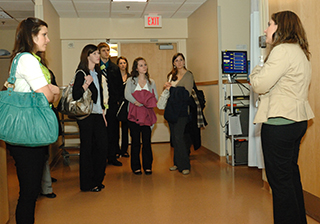 |
Dr. Amber Courville (right) led a tour of the metabolic clinical research unit for area dietetic interns.
|
Future and current dietitians learned about the role of their profession in clinical research at the annual NIH Nutrition Research Day on March 17. The Clinical Center Nutrition Department has hosted this event for more than 10 years.
Event attendees included graduate students, dietetic interns, registered dietitians, and junior faculty participating in the week-long National Cancer Institute/CC Nutrition and Cancer Prevention Research Practicum, as well as additional dietetic interns from the Washington, DC, metro area. The day was coordinated by Merel Kozlosky, dietetic internship director, who expressed how rewarding it is to share the work of NIH dietitians with the outside professional community.
"It's really exciting to learn about current research," said Genevieve Clarke, who is a dietetic intern at Virginia Tech and is interested in renal patients and sports nutrition.
NIH Nutrition Research Day attendees heard from Dr. Amber Courville, a CC metabolic research dietitian, who explained the clinical research process and how the Nutrition Department supports and conducts studies. She broke down the average distribution of clinical research dietitians' time: 45 percent patient care, 23 percent hospital support, and 32 percent research services and support. Approximately 100 protocols at the CC require nutrition research services—such as research diets, body composition measurements, eating behavior assessments, and nutrition counseling—Courville said.
Throughout the day Courville and fellow dietitians Rachael Lopez, Jennifer Graf, and Diane DellaValle presented protocols they work on and their contributions to those studies. Dr. Amy Subar, an NCI nutritionist, spoke on "New Methods of Dietary Assessment." Both groups of attendees took a tour of the Clinical Center, including the metabolic clinical research unit, and practicum participants also heard from CC dietitian Marine Dobbin on "Botanical and ‘Other' Dietary Supplements."
Another valuable presentation came from dietitians across NIH who charted their career paths for the younger generation. Dr. Abby Ershow of the National Heart, Lung, and Blood Institute empowered the audience, "Dietitians, in this age of dietary guidelines, in helping people to take all this information and make it real, you all have a crucial role in improving human health."
Dr. Rosalind Breslow of the National Institute of Alcohol Abuse and Alcoholism told the story of her unplanned path into nutrition from singing and acting. "Some of us have linear paths, and some of us don't," she said. "Whatever works is ok!"
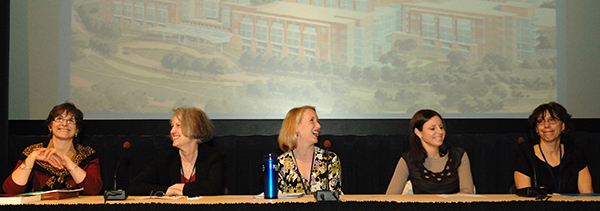 |
Dietitians from across NIH—(from left) Dr. Abby Ershow (NHLBI), Dr. Rosalind Breslow (NIAAA), Dr. Kirsten Zambell (CC), Janet de Jesus (NHLBI), and Dr. Margaret McDowell (NIH DNRC)—told the audience of their paths to the panel.
|
Back to Top
NIH community hears of the human side of HeLa
By: Nicole Martino
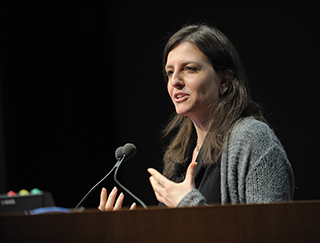 |
Science writer Rebecca Skloot told the story of Henrietta Lacks, the woman behind the legacy of "HeLa" cells, to a packed Masur Auditorium this March.
|
When NIH Director Dr. Francis S. Collins asked a packed Masur Auditorium on March 14 how many had used HeLa cells in their work at NIH, he saw a forest of hands in the air.
Rebecca Skloot, an award-winning science writer and author of the bestselling book, "The Immortal Life of Henrietta Lacks," presented the story of the woman previously known to many within the scientific community just as "HeLa" at the annual J. Edward Rall Cultural Lecture. Through readings, explanations, and responses to audience questions, Skloot explained the legacy of the poor African-American woman whose cells—taken without her knowledge in 1951—became one of the most important tools in medicine. Her cells were vital for developing the polio vaccine, cloning, gene mapping, in vitro fertilization, and more.
"There have been few books in recent times that have captivated the international reading audience about science in the way that this has," said Collins in his introduction.
Skloot wrote how Lacks was diagnosed and treated for an aggressive cervical cancer at Johns Hopkins in 1951. Although she consented to a biopsy and to treatment, she was not informed that the doctors gave a sample of her cancerous tissue to a laboratory that had long been trying to grow an immortalized human cell line. Since that time, ethical standards have evolved so that individuals give consent to donate their samples for research, or in some cases samples derived from clinical specimens are de-identified to minimize any confidentiality risk to the individual.
"Scientists all over the world, and many here on this very campus, had been trying to grow human cells outside of the body for decades, but it never really worked," Skloot said. Lacks' cells were given to Johns Hopkins researcher Dr. George Gey, who discovered that Lacks' cells not only survived, but grew rapidly and abundantly, something scientists had never seen before.
Gey began distributing Lacks' cells to laboratories all over the world, providing the scientific community with the first reliable tool for medical research. According to Skloot, Lacks' cells were the first human cells ever commercialized, having since been bought and sold by the millions. Skloot smiled saying she didn't even want to think about how many of Lacks' cells were on the NIH campus at that moment.
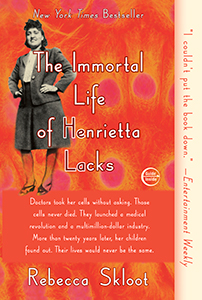 |
Skloot's debut book "The Immortal Life of Henrietta Lacks" became an instant New York Times bestseller.
|
As their mother's cells were bought and sold, the Lacks family continued to live in poverty and frequently poor health, without the resources to go to the doctor. Their discovery of their mother's unknowing contribution decades later left them full of anger, confusion, and suspicion. For years, Skloot compassionately gathered information about Lacks, sharing with the family along the way, eventually gaining the trust and forming a relationship with Lacks' daughter Deborah.
At the March lecture, Skloot also addressed some of the complicated ethical questions brought up by patient contributions to scientific discovery.
"This book is about many things, and one of the things it's about is scientific illiteracy and the importance of the general public having access to scientific information," she said, emphasizing how people, including Lacks' family, often misunderstand scientific and medical information. Skloot stressed the responsibility of physicians and scientists to convey that information in a clear way.
"Skloot's story of Henrietta Lacks and her family serves as a powerful reminder to all of us that the source of every cell or tissue sample we use in research is an individual with unique motivations, needs, understandings, and social structures," said Dr. Christine Grady, deputy chief of the Clinical Center's Bioethics Department. "Accordingly, we should continue to strive to educate the public about research, show appreciation to individuals who donate samples, and utilize their contributions wisely."
Skloot closed her lecture encouraging the NIH community, especially clinician-scientists, to engage in back and forth communication with their patients and the public. "Ask people what they just heard," she said. "Unfortunately, most of the people out there don't speak science."
Skloot is the founder and president of the Henrietta Lacks Foundation, which was started with a portion of the proceeds of the book and accepts individual and industry donations. The foundation has paid the cost of college tuition and books for eight of Lacks' descendants and in the future plans to offer assistance to other individuals whom have been used in research without their consent.
Skloot's presentation was part of the NIH Director's Wednesday Afternoon Lecture Series. "The Immortal Life of Henrietta Lacks"—her debut book—took her over a decade to research and write, and became an instant New York Times bestseller. It won the Chicago Tribune Heartland Prize and the Wellcome Trust Book Prize and was named a 2010 best book of the year by Amazon.com; Entertainment Weekly; O, The Oprah Magazine; and numerous others.
Back to Top
Surrogates confront tough decisions
Making medical decisions for an incapacitated loved one has negative effects on approximately one-third of surrogates, finds a new study published by Clinical Center Bioethics Department researchers.
Dr. David Wendler, chief of the Unit of Vulnerable Populations, and former post-doctoral research fellow Dr. Annette Rid authored "Systematic Review: The Effect on Surrogates of Making Treatment Decisions for Others" that ran in late February in Annals of Internal Medicine. They reviewed 40 studies that provided data from 2,854 surrogates, of whom more than half were family members of the patient.
"Since incapacity often occurs as a result of serious conditions, surrogates' decisions often involve important choices, especially at the end of life," Wendler said. "Placement in nursing or long-term care facilities is another decision they make."
Negative effects—such as stress, guilt, and doubt about the decisions they had made—stayed with study responders for months, and sometimes years, the article said.
"Nine of the 40 studies also reported beneficial effects on a few surrogates, the most common of which were supporting the patient and feeling a sense of satisfaction," the authors wrote.
Subjects frequently said knowing how the patient would have wanted to proceed alleviated some of the negative effects for patient surrogates.
"Knowing the patient's wishes often transforms the situation from one in which surrogates feel that they are making life and death decisions for the patient to one in which they feel that they are merely communicating the patient's wishes or standing up for the patient," said Wendler.
He and Rid recommended future research examine ways to alleviate some of the burden of surrogate decision making.
Back to Top
Conference focuses on managing symptoms
Millions of Americans suffer from symptoms such as fatigue, pain, and insomnia related to chronic illnesses and their treatments.
Developing new and better ways to manage these symptoms is vital to improving quality of life for these patients and is an important area of translational research for the National Institute of Nursing Research (NINR).
To highlight recent symptom research, the NINR and Clinical Center Nursing and Patient Care Services are cosponsoring a joint conference: Symptom Mechanisms, Measurement, and Management. This free, one-day event will take place from 8 am to 3:30 pm on May 12 in the Masur Auditorium.
Distinguished guest speakers from across the country will present lectures on a variety of symptom-related topics including symptom self-management in oncology patients, pain management at end-of-life, sleep disorders, and genetic mechanisms of cancer treatment-related fatigue.
The conference is part of the NINR's series of anniversary events commemorating the institute's 25 years at the NIH and the contributions of nursing science to meeting some of America's most important health challenges.
Symptom Mechanisms, Measurement, and Management will also feature a poster session.
Contact Crystal Esler at 301-496-9629 or eslercm@mail.nih.gov with questions. To register, visit www.ninr.nih.gov/25years.
Back to Top
New exhibit offers glimpses into CC history
![A woman views the new exhibit]() |
A new art and photography exhibit on the first floor of the Magnuson building (near the pediatrics clinic) gives visitors a window into the Clinical Center's history, from the construction of the original Magnuson center in the late 1940s, to the dedication of the new Hatfield building in 2004. Robyn Bent of the National Cancer Institute, pictured above, stopped to investigate an article published by the New York Times in July 1953 featuring the CC's dedication ceremony. The article describes the spectacular opening of the new facility designed specifically for translational research. |
Back to Top
NIH offers entrance just for patients, their families and visitors
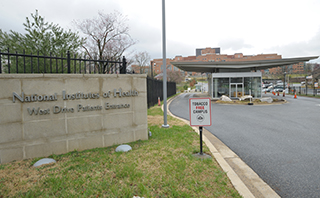 |
The West Drive patient entrance is located directly north of the CC's North entrance to ease patient navigation.
|
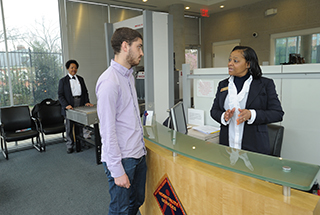 |
A patient visitor is greeted by CC hospitality staff member Letitia Johnson (right). Johnson guides visitors through the facility and gives them an idea of what to expect once they arrive at the CC.
|
Just as the Hatfield Building was designed to facilitate translational research, the Clinical Center's patient entrance at the intersection of West Cedar lane and West Drive was designed with CC patients in mind.
Directly north of the CC's North entrance and next to The Children's Inn, the patient entrance offers specially tailored campus access and services to the CC's patients, their family members, and patient visitors.
"It really is the first contact a patient has with the Clinical Center," said Denise Ford, chief of the Office of Hospitality Services. The entrance offers services identical to those offered at the Gateway Center for other campus visitors, on a smaller more customer service oriented scale.
The west drive patient entrance receives anywhere between 200 to 300 visitors each day. "It is important because it streamlines the patient's entryway onto campus and the staff is specially trained around the Clinical Center's mission," said Ford.
When patients and their visitors pull up to the west drive entrance, they are routed into two different entryways—one for first time patients and their visitors and one for people who have been to the NIH to visit the CC before.
The security personnel invite patients and their visitors to enter the facility to obtain a day pass to campus, and offer assistance with any belongings or luggage that also needs to be scanned inside the facility.
Patients don't even have to exit the vehicle if they are not feeling well or if it would be too cumbersome for them to do so, security staff can bring the badging and check-in process to them. "We want it to be caring and supportive, but also simplified and efficient," said Ford.
The center is typically staffed by five individuals, including CC hospitality staff member Letitia Johnson, who welcomes patients and their companions to the NIH in the mornings, the busiest arrival time. Johnson addresses any initial inquires they might have and makes sure they get where they need to go.
"A lot of times patients are anxious about their arrival, so I try to ease their mind about what to expect," she said. Johnson says she understands how stressful a visit to a hospital can be, which is why it is important to offer the best customer service possible from the moment they step onto campus.
Campus access for patients and patient visitors: |
- West Drive patient entrance: Use weekdays 7am - 7pm
- NIH Gateway Center: Use when the West Drive patient entrance is closed
- Commercial Vehicle Inspection Facility (CVIF): Use on weekdays after 10pm and on weekends and Holidays
|
"We don't want security to be a deterrent to a positive patient experience," Ford said, describing the overwhelmed look many of the CC's first time visitors have upon entering the building.
"I love helping the patients and trying to make their visit a little easier," said Johnson of her job at the facility.
Many of the individuals that currently utilize the patient entrance are new admissions. But according to Ford, staff and security personnel encourage patients and their visitors to use the entrance even after they have received an extended visitor pass.
The west drive patient entrance is open Monday through Friday (except federal holidays) from 7 am to 7 pm, and a photo ID is required for those ages 16 and older. At other times, visitors and patients can enter campus through the main public entrance at the NIH Gateway Center, which is located at Rockville Pike and NIH Gateway Drive.
There is no exit from the west drive patient entrance, but visitors may exit campus through any open exit, including those designated for employees.
After 10:00 pm on weekdays and on all weekends and holidays, visitors can enter campus through the Commercial Vehicle Inspection Facility (CVIF), on Rockville Pike between North Drive and Wilson Drive.
| |
The staff at the west drive patient entrance (from left) Lt. Jefferson, Victor Amudipe, Harry Chu, Centonia Reid, Letitia Johnson, Cynthia Hart, and Gwendolyn Shepphard.
| The West Drive patient entrance is located directly north of the CC's North entrance to ease patient navigation.
|
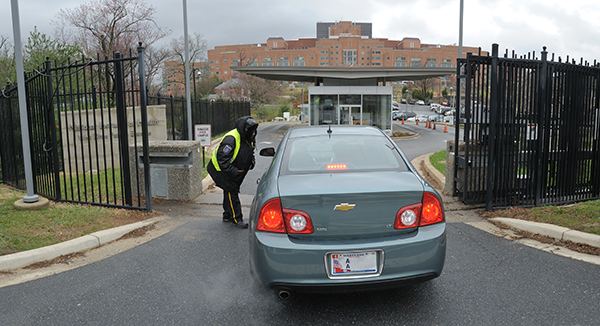 |
Officer Ried welcomes a patient and their companions to the west drive patient entrance. When vehicles pull up to the gate, they are greeted by an officer who either directs visitors towards vehicle inspection, or if they have extended visitor badges, invites them to enter campus.
|
Back to Top
Lodge employee celebrates 40 federal years
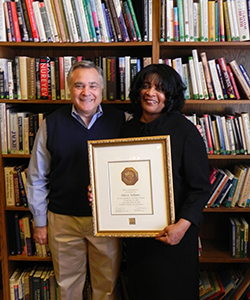 |
Ellen Williams (right) celebrated 40 years of federal service this March. She is pictured alongside her supervisor Larry Eldridge in her favorite room at the Edmond J. Safra Family Lodge, the library.
|
Although she says she feels like she has just started, Ellen Williams, currently the manager of guest relations at the Edmond J. Safra Family Lodge, celebrated 40 years of federal service in February.
"I feel like this is home," she said. "I have has very good experiences here. I've grown a lot and had the opportunity to truly realize my own potential."
Williams began her government service in 1971 at the Department of Commerce but came to the NIH one year later to work for what was then the Clinical Center Department of Clinical Pathology. She has held a variety of positions at the CC, progressing from an Office of Equal Employment Opportunity Assistant to an Officer. Williams has worked at the Family Lodge since it opened in 2005.
"There are a lot of opportunities here," she said. "I remember, when I started, NIH was like a huge college campus. It was fun working here, and I realized my life was changing and whatever I wanted to do, I could do it here."
Williams' supervisor Larry Eldridge, executive director of the Family Lodge, describes her as an invaluable resource to staff as well as patients and their loved ones. "We have all benefited from Ellen's superb customer service skills and her ideas and suggestions that have improved the quality of the environment for our guests," he said.
As a caregiver herself, Williams has found that her work at the lodge complements her spirituality and experiences providing care to her parents. Williams also pays special attention to the needs and preferences of all the guests at the lodge, even going so far as to do research on different cultural competencies of the guests. She plans to sign up for Spanish lessons so she can provide the best customer service possible, which she says is her favorite part of the job.
Williams encourages other CC employees to take advantage of training opportunities and to find a mentor within the NIH community. "I have had many wonderful mentors who have pushed me to explore other avenues. Some of them have even seen things in me that I didn't."
Back to Top
Remembering a patient who moved all she met
By: Wendy Schubert
Clinical Center and institute staff joined the family of Kelsey Koch in a memorial service to honor her life and passing. They filled the chapel to remember the remarkable 22-year old woman who touched their lives throughout her battle with DOCK-8 deficiency.
Part of a subgroup of patients diagnosed with Job's syndrome who did not present with the syndrome's normal symptoms, both Kelsey and her sister contributed to the identification of DOCK8 deficiency. The disorder makes patients more susceptible to deadly infections and cancers such as lymphomas.
"Kelsey moved us all, here," said Carissa Haney, a nurse practitioner who cared for her closely. "Her perseverance laid the foundation for others with her illness to carry on."
Organized by Carissa Haney and nurse Dirk Darnell as well as Chaplain Valerie Hayes, the memorial featured lively music and dance tributes by the Koch family, as well as eloquent statements by NIAID laboratory and CC patient care staff. For researchers and caregivers alike, Kelsey gave Dock-8 deficiency an unforgettable point of reference, which spurred them on to find answers to this life-threatening condition.
Everyone recalled her exuberant, caring attitude, which inspired and motivated others. The words, "grace," "confidence," and "courage" echoed from each speaker who recounted how Kelsey positively affected everyone she met.
"I will always remember her resilience, her intelligence, and her sense of humor. She went through this with such grace and dignity," recalled Darnell, Kelsey's case manager. "She made me a better nurse."
As a student at Ball State University, Kelsey was also a passionate advocate for research and bone marrow donation. "She was an extremely mature, graceful person, dedicated to research," said Dr. Alexandra Freeman, her attending physician.
A previous CCNews story about Kelsey and her family was published in September 2010: http://www.cc.nih.gov/about/news/newsletter/2010/sept10/newsletter.html
Back to Top
Patient family's gift supports CC staff and research
 |
A former patient's (from left) brothers-in-law Gordon Tully and Frederick Fisher, along with the patient's widow Josephine (Jolly) de Give, visited the Clinical Center in March to see the renovated ICU staff lounge and cell sorting machine provided for by their family foundation. There in appreciation of the gift were Dr. Henry Masur, chief of the CC Critical Care Medicine Department; Dr. Austin John Barrett, NHLBI principal investigator; and Dr. Scott Campbell, executive director and CEO, FNIH.
|
The family of a former Clinical Center patient returned to the intensive care unit on March 2 to bestow a gift of appreciation to staff and researchers.
David de Give received a stem cell transplant to treat his myelodysplastic syndrome—in which the bone marrow does not make enough healthy blood cells—at the CC in August 2008. He returned home and enjoyed life for many months, said his wife Josephine (Jolly). With complications, David was admitted to the ICU in April 2009 and died that June.
"Not only did we have the best and most skilled care from the wonderful physicians and nurses, but everyone, from the top physicians to the parking attendant who stamped our parking ticket each morning, were universally friendly, warm and caring. This atmosphere helped so much when things were going well, and it helped even more when things were not going well," Jolly said.
She, along with many family members, visited in March to see the renovated ICU staff lounge and new fluorescence-activated cell sorting (FACS) machine bought with a generous gift from their family trust, the Friendship Fund, in cooperation and with assistance from the Foundation for NIH (FNIH).
"We really appreciate your acknowledgement of the staff and how important they are," Dr. Henry Masur, chief of the CC Critical Care Medicine Department, told the de Give family. "We will remember your contribution every time we use the room."
The FACS machine uses antibodies to "label" the different "flavors" of white blood cells—suppressor, effecter, memory cells, for example. Monitoring the presence of different cells in the event of disease such as graft-versus-host can help develop diagnostics and treatments.
"We use the machine every day," said Dr. Austin John Barrett, principal investigator in the hematology branch of the National Heart, Lung, and Blood Institute.
The visit was jointly arranged by the CC and the FNIH. Dr. Scott Campbell, FNIH executive director, added that, "FNIH frequently hears from grateful patients and their families about the care they've received from the ICU staff and doctors. We are honored to be part of this tribute to David and the outstanding staff of the ICU."
Back to Top
"Medicine for the Public" to discuss obesity and depression
The 2011 "Medicine for the Public" lecture series will present the latest in research for prevention and treatment of obesity and depression in two sessions this May at Suburban Hospital in Bethesda, Md.
Since 1977, NIH researchers have educated the public about biomedical research through yearly "Medicine for the Public" programs. The lectures are presented in collaboration between the Clinical Center; Suburban Hospital and Johns Hopkins Medicine.
The May 17 lecture—"Confronting Obesity: Updates in Prevention and Treatment in Research"—will include presentations from Dr. Kong Y. Chen, director of the Metabolic Research Core and the Diabetes, Endocrinology, and Obesity Branch at the National Institute of Diabetes, Digestive, and Kidney Diseases; Dr. Lawrence Appel, professor of Internal Medicine and director of the Welch Center for Prevention, Epidemiology and Clinical Research at Johns Hopkins Medicine; and Dr. Tania Heller, Suburban Hospital physician and medical director of the Washington Center for Eating Disorders and Adolescent Obesity, and clinical assistant professor at Georgetown University Hospital.
The May 24 lecture titled "Challenging Depression: New Insights into Research and Treatment" will be presented by Dr. Carlos A. Zarate Jr, chief of the Experimental Therapeutics and Pathophysiology Branch at the National Institute of Mental Health; Dr. Jennifer Lanier Payne, assistant professor of psychiatry and behavioral sciences at Johns Hopkins Medicine; and Dr. David T. George, Suburban Hospital psychiatrist and associate medical director of ECT Services.
The event is free and open to the public. Both lectures will run from 7:00 to 8:30 pm in the Suburban Hospital Auditorium, with registration and refreshments at 6:30 pm.
To register in advance, call 301-896-3939. Visit http://www.cc.nih.gov/about/news/mfp.shtml for more information.
Back to Top
Upcoming Lectures
All will be videocast at http://videocast.nih.gov
April 6
Ethics Rounds
Should All Research Subjects Be Treated the Same?
Baruch A. Brody, Ph.D., Leon Jaworski Professor of Biomedical Ethics and Director of the Center for
Medical Ethics and Health Policy, Baylor College of Medicine, and Andrew Mellow Professor of Humanities,
Department of Philosophy, Rice University
Case Presenter: Stephen A. Migueles, MD, HIV-Specific Immunity Section, NIAID
April 13
Contemporary Clinical Medicine: Great Teachers
Hepatitis E: An Emerging Infectious Disease
Jay H. Hoofnagle, MD
Director, Liver Disease Research Branch
Division of Digestive Diseases and Nutrition, NIDDK
April 20
Pilot Study of MRI-guided High Intensity Focused Ultrasound Ablation of Uterine Fibroids
Pamela Stratton, MD
Head, Gynecology Consult Service
Program in Reproductive and Adult Endocrinology, NICHD
A New Approach to Primary Ovarian Insufficiency
Lawrence M. Nelson, MD
Head, Integrative Reproductive Medicine Group
Intramural Research Program on Reproductive and Adult Endocrinology, NICHD
April 27
Fetal Alcohol Syndrome: Etiology, Epidemiology and Advances in Diagnosis
Kenneth R. Warren, PhD
Acting Director, NIAAA
Back to Top
New clinical research protocols
- The following new clinical research protocols were approved in February:
- A Pilot Study to Test the Feasibility of the Combination of Gemcitabine and CT-011 in the Treatment of Resected Pancreatic Cancer; 11-C-0100; Dr. Samir N. Khleif; NCI
- A Phase I/II Study of TRC105 in Combination with Sorafenib in Hepatocellular Carcinoma (HCC); 11-C-0102; Dr. Tim F. Greten; NCI
- Acquisition of Blood and Tumor Tissue Samples from Patients with Gastrointestinal Cancer; 11-C-0112; DR. Tim F. Greten; NCI
- Treatment of Non-infectious Intermediate and Posterior Uveitis Associated Macular Edema with Intravitreal Methotrexate; 11-EI-0107; Dr. Annal D. Meleth; NEI
- Viral Infections in Healthy and Immunocompromised Hosts; 11-I-0109; Dr. Jeffrey I. Cohen; NIAID
- A Randomized Within-Subject, Double-Blind, Placebo-Controlled Study of Dexamethasone Irrigation of the Parotid Glands in Primary Sjögren's Syndrome Subjects; 11-D-0094; Dr. Ilias Alevizos; NIDCR
- Observational Study of Persons with Hepatitis B Virus Infection in North America (Cohort Study); 11-DK-0108; Dr. Marc G. Ghany; NIDDK
- Imaging Serotonin 5-HT1A Receptors in the High Affinity State in Brains of Patients with Major Depressive Disorder; 11-M-0097; Dr. Christina S. Hines; NIMH
Back to Top
This page last updated on 12/20/2017


 The information on this page is archived and provided for reference purposes only.
The information on this page is archived and provided for reference purposes only.